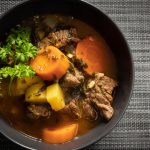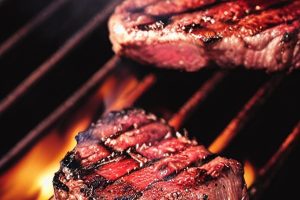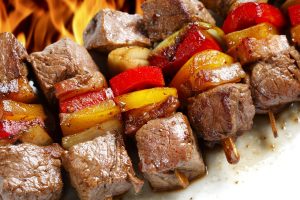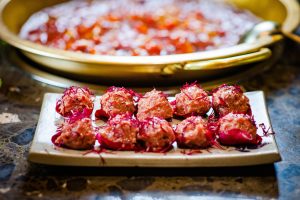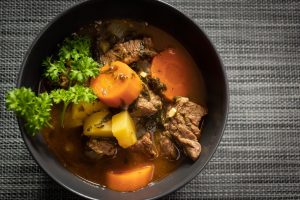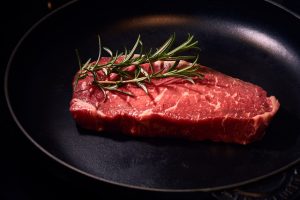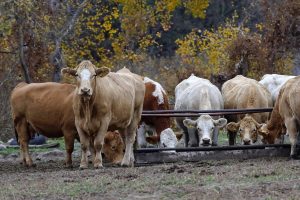Uncovering the Ancient Origins of Moo Shu Beef: A Culinary Journey Through History
Are you ready to embark on a culinary journey through time? Buckle up, because we’re about to uncover the ancient origins of moo shu beef. Get ready to have your taste buds tickled and your funny bone tickled in this persuasive and humorous exploration of the history behind this delectable dish.
Picture this: you’re sitting in a Chinese restaurant, perusing the menu, and your eyes land on moo shu beef. You can practically taste the savory flavors and feel the tender beef melting in your mouth. But have you ever wondered where this dish originated? Well, my friend, prepare to be amazed.
Legend has it that moo shu beef was created by an ancient Chinese emperor who had a penchant for all things delicious. One day, as he sat in his palace, he grew tired of the same old dishes and demanded that his royal chefs create something new and exciting. And thus, moo shu beef was born!
Now, let’s fast forward a few centuries to the time of the Silk Road. Traders from all over the world would gather in bustling marketplaces, exchanging goods and ideas. It was during this time that moo shu beef made its way into the hearts and stomachs of people far and wide.
As the dish traveled along the Silk Road, it picked up influences from various cultures, adding layers of flavor and complexity. The tender beef was marinated in a mixture of soy sauce, ginger, and garlic, giving it a rich and savory taste. It was then stir-fried with an array of colorful vegetables, creating a visually stunning dish that was as pleasing to the eyes as it was to the palate.
But wait, there’s more! As moo shu beef continued its journey through history, it found its way to the United States, where it was embraced with open arms (and mouths). American chefs put their own spin on the dish, adding ingredients like cabbage and mushrooms to give it an extra crunch and earthy flavor. It quickly became a staple in Chinese-American cuisine, delighting taste buds across the nation.
So, the next time you order moo shu beef, take a moment to appreciate the rich history behind this culinary masterpiece. From the ancient Chinese emperor’s craving for something new to the bustling marketplaces of the Silk Road, this dish has traveled through time and cultures to bring joy to our taste buds.
In conclusion, the ancient origins of moo shu beef are a testament to the power of food to unite people and bridge cultures. So, the next time you take a bite of this delicious dish, remember the journey it has taken to reach your plate. And who knows, maybe one day you’ll create your own culinary masterpiece that will stand the test of time.
But for now, sit back, relax, and enjoy the mouthwatering flavors of moo shu beef. Happy eating, my fellow culinary adventurers!
A Glimpse into the Origins of Moo Shu Beef: Tracing its Roots to Ancient Chinese Cuisine
Are you a fan of Chinese cuisine? Do you enjoy the delectable flavors and unique combinations that make it so special? Well, get ready to have your taste buds tantalized because we are about to take a journey back in time to discover the origins of one of our favorite dishes – Moo Shu Beef!
Now, you may be wondering, what makes Moo Shu Beef so special? Is it the tender strips of beef? The crisp vegetables? Or perhaps the savory hoisin sauce that brings it all together? Well, my friend, it is all of these things and more. But before we delve into the deliciousness of this dish, let’s travel back to ancient China and explore its roots.
Legend has it that Moo Shu Beef was first created during the Tang Dynasty, a time when emperors ruled the land and culinary arts flourished. It is said that a brilliant chef named Li Bo was tasked with creating a dish fit for a king. And boy, did he deliver!
Li Bo was known for his creativity and his ability to transform simple ingredients into culinary masterpieces. Inspired by the beauty of the landscape, he sought to create a dish that would capture the essence of China. And thus, Moo Shu Beef was born.
Picture this: Li Bo in his bustling kitchen, surrounded by a symphony of sizzling pans and fragrant spices. He starts by marinating strips of beef in a secret blend of seasonings, infusing them with a tantalizing aroma. Then, he sautés them over a high flame until they are perfectly tender and succulent.
But Li Bo doesn’t stop there. Oh no, he takes it to another level by adding a colorful array of vegetables. Thinly sliced cabbage, carrots, and mushrooms dance in the pan, soaking up the flavors of the beef and creating a beautiful medley of textures.
And let’s not forget about the sauce! Li Bo knew that a great dish needed a great sauce, so he concocted a magical blend of hoisin sauce, soy sauce, and a touch of sweetness. This sauce, my friends, is what brings Moo Shu Beef to life. It coats every morsel with its lusciousness, creating a symphony of flavors that is simply irresistible.
So there you have it, a glimpse into the origins of Moo Shu Beef. From the creative genius of Li Bo to your plate, this dish has stood the test of time and has become a staple in Chinese cuisine. So the next time you indulge in a plate of Moo Shu Beef, remember the journey it has taken and savor every bite. After all, it’s not just a dish – it’s a taste of history!
Exploring the Historical Significance of Moo Shu Beef: From Traditional Chinese Cooking to Modern Delicacy
Moo Shu Beef, the beloved dish that has captured the hearts and taste buds of food enthusiasts worldwide. This delightful concoction of tender beef, crunchy vegetables, and savory sauce wrapped in a delicate pancake is not just any ordinary Chinese dish. Oh no, it is so much more! Moo Shu Beef holds a historical significance that traces back to traditional Chinese cooking, making it a true culinary treasure. And let’s not forget, it has also become a modern delicacy that continues to delight our palates with its irresistible flavors. So, let’s embark on a journey to explore the rich history and mouthwatering appeal of Moo Shu Beef.
To truly appreciate the historical significance of Moo Shu Beef, we must first understand its roots in traditional Chinese cooking. Legend has it that this dish originated in the northern regions of China, where pancakes were a staple. These pancakes were made from dough and cooked on a hot griddle, resulting in a thin and pliable wrap. The ingenious chefs of ancient China saw an opportunity to create a dish that combined the versatility of these pancakes with the rich flavors of their culinary traditions.
Enter the hero of our story – the beef. In traditional Chinese cooking, beef was highly valued for its rich taste and nutritional benefits. It was often reserved for special occasions and festive celebrations. The addition of beef to the Moo Shu dish elevated it to new heights, making it a symbol of indulgence and opulence.
But what about the vegetables, you ask? Well, let’s not underestimate their role in this delectable ensemble. The inclusion of vegetables such as cabbage, mushrooms, and carrots not only added vibrant colors and textures but also provided a healthy balance to the dish. It was a perfect harmony of flavors and nutrition, making Moo Shu Beef a well-rounded meal that satisfied both the taste buds and the body.
Now, fast forward to the modern era, where food has become an art form and a source of constant experimentation. Moo Shu Beef has undergone a delightful transformation, adapting to the ever-changing tastes and preferences of food enthusiasts. Chefs have playfully experimented with different variations, adding their unique twists to this timeless classic.
Today, you can find Moo Shu Beef with a myriad of different ingredients. From succulent shrimp to crunchy tofu, the possibilities are endless. This evolution has only enhanced the appeal of Moo Shu Beef, making it a dish that can cater to the preferences of every palate. It has truly become a modern delicacy that showcases the culinary creativity of our time.
So, my fellow food lovers, let us celebrate the historical significance and mouthwatering appeal of Moo Shu Beef. From its humble beginnings in traditional Chinese cooking to its modern-day reinvention, this dish has stood the test of time. It has delighted generations with its flavors, textures, and cultural significance. So, the next time you sink your teeth into a scrumptious Moo Shu Beef pancake, take a moment to appreciate the journey it has taken. And remember, it’s not just a delicious meal – it’s a piece of culinary history.
The Evolution of Moo Shu Beef: Unraveling the History Behind this Authentic Chinese Dish
Are you ready to embark on a journey through time and space? Well, maybe not space, but definitely time. Today, we are going to unravel the fascinating history behind one of the most beloved dishes in Chinese cuisine – Moo Shu Beef. Prepare yourself for a tantalizing tale filled with intrigue, mystery, and of course, mouthwatering flavors.
Imagine yourself in ancient China, where culinary traditions were being created and perfected. It is believed that the origins of Moo Shu Beef can be traced back to the Han Dynasty, which lasted from 206 BCE to 220 CE. Legend has it that a clever chef, with a mischievous twinkle in his eye and a passion for deliciousness, came up with the idea of combining tender beef with an assortment of fresh vegetables.
But wait, there’s more! As the story goes, this innovative chef had a mischievous sense of humor. He loved to entertain his guests with his culinary creations. One day, he decided to serve his new dish in a unique way – wrapped in thin, delicate pancakes. Picture yourself biting into a savory parcel filled with succulent beef and vibrant veggies. It’s like unwrapping a delicious gift with every bite.
As time went on, Moo Shu Beef gained popularity across the land. It became a staple in Chinese cuisine, delighting the taste buds of emperors, scholars, and commoners alike. With each passing dynasty, new ingredients and variations were added to this beloved dish. From the Tang Dynasty’s addition of fragrant mushrooms to the Qing Dynasty’s inclusion of luscious bamboo shoots, the evolution of Moo Shu Beef was unstoppable.
Fast forward to the present day, and we find ourselves in a world where culinary traditions have crossed borders and oceans. Moo Shu Beef has made its way into Chinese restaurants around the globe, enchanting food enthusiasts with its harmonious blend of flavors and textures. It has become a symbol of authentic Chinese cuisine, a dish that bridges the gap between ancient history and modern-day dining.
So, what are you waiting for? Embark on a culinary adventure and savor the rich history behind Moo Shu Beef. Let your taste buds be whisked away to a time when innovation and humor shaped the culinary landscape. Whether you choose to enjoy it in a traditional Chinese restaurant or attempt to make it at home, one thing is for certain – Moo Shu Beef will continue to captivate and delight for generations to come.
From the Imperial Kitchens to Contemporary Cuisine: The Fascinating Story of Moo Shu Beef’s Origins
From the Imperial Kitchens to Contemporary Cuisine: The Fascinating Story of Moo Shu Beef’s Origins
Are you ready to embark on a mouthwatering journey that will tickle your taste buds and leave you craving for more? Well, get ready to savor the tantalizing tale of Moo Shu Beef’s origins – a story that takes us from the opulent Imperial Kitchens to the cutting-edge realm of contemporary cuisine. Hold on tight, because this story is as deliciously persuasive as it is humorously entertaining!
Picture this: the majestic Imperial Kitchens of ancient China, bustling with the finest chefs meticulously crafting culinary masterpieces fit for emperors and empresses. In this sumptuous setting, a humble dish was born – Moo Shu Beef. Legend has it that it was Emperor Guangxu himself who first tasted this divine combination of tender beef, fresh vegetables, and savory spices. With one bite, he knew this dish was fit for royalty and bestowed it with the regal name of Moo Shu Beef.
Fast forward to modern times, and we find ourselves in a world of culinary innovation where tradition meets experimentation. The story of Moo Shu Beef has transcended time and space, evolving with each generation of talented chefs who have put their unique spin on this classic dish. From the sizzling streets of Beijing to the bustling food trucks of New York City, Moo Shu Beef has become a global sensation.
But what makes Moo Shu Beef so special, you ask? Well, dear food enthusiast, it’s all about the harmonious blend of flavors and textures. Imagine sinking your teeth into tender slices of beef, delicately seasoned with a symphony of spices. Then, add a medley of crisp vegetables like cabbage, carrots, and mushrooms, all stir-fried to perfection. Finally, wrap this delectable concoction in a warm, pillowy pancake, and you’ve got yourself a culinary masterpiece that will transport your taste buds to paradise.
Now, let’s talk about the persuasive powers of Moo Shu Beef. One bite of this mouthwatering delight, and you’ll find yourself instantly converted into a lifelong fan. The tender beef melts in your mouth, while the fresh vegetables offer a satisfying crunch. The flavors dance on your palate, leaving you craving for more. It’s impossible to resist the allure of Moo Shu Beef – a dish that has stood the test of time and continues to captivate food lovers around the world.
But let’s not forget the humor in this story. After all, food is meant to be enjoyed with laughter and good company. Just imagine the emperor himself, with his regal robes and elaborate headpiece, indulging in the simple pleasure of Moo Shu Beef. It’s a delightful image that reminds us that sometimes the most extraordinary experiences can come from the simplest of pleasures.
So, dear reader, are you ready to embark on your own Moo Shu Beef adventure? Prepare to be whisked away on a journey that will tantalize your taste buds, captivate your senses, and leave you with a newfound appreciation for the rich history and vibrant flavors of Chinese cuisine. Get ready for the deliciously persuasive and humorously entertaining story of Moo Shu Beef’s origins – a tale that will have you craving a taste of this culinary masterpiece in no time!



